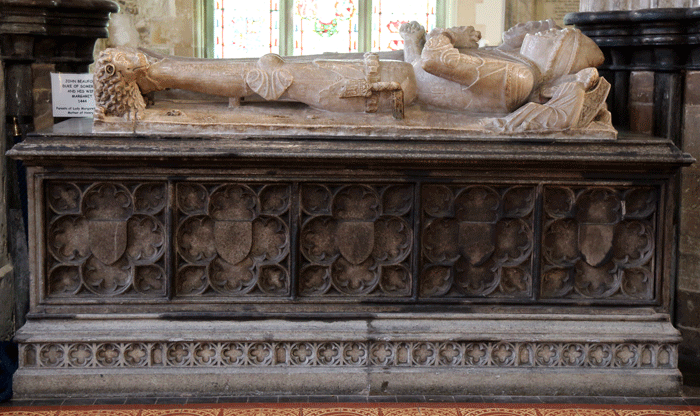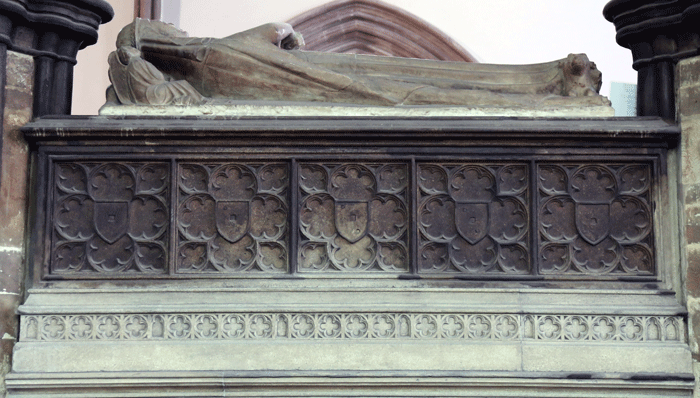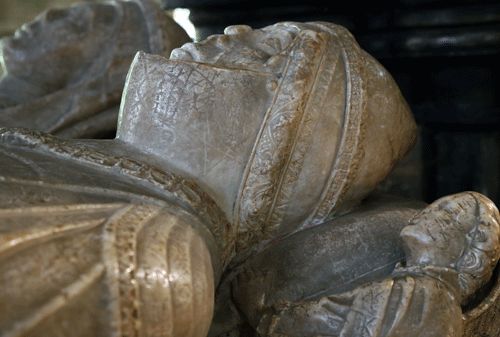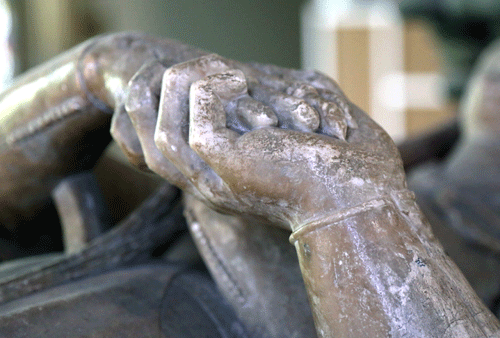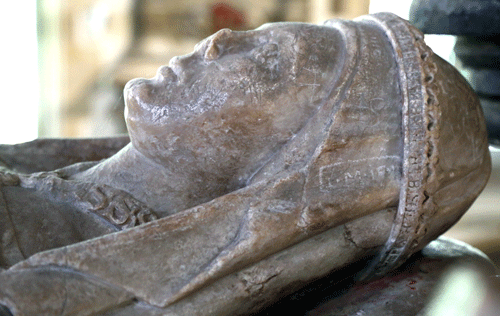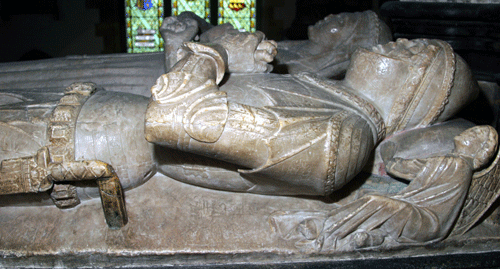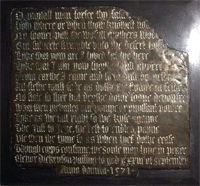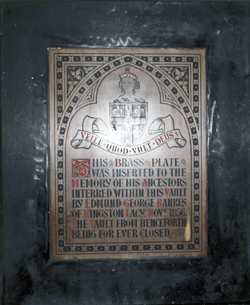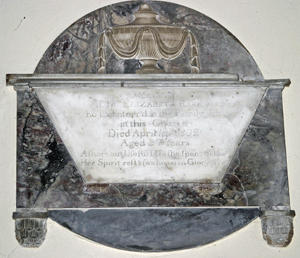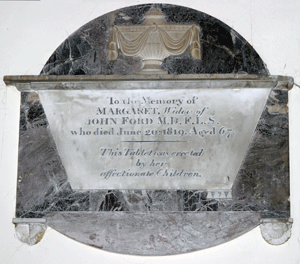Sherborne Abbey Silton Stalbridge Stourton Caundle Tolpuddle Trent Wareham Priory Wareham (St Martin) (West Chelborough) West Knighton West Stafford Wimborne Minster Wimborne St Giles
Whitchurch Canonicorum Winterborne Came
< Home - Index - Page> <Dorset - 1> <Dorset - 2> <Dorset - 3>
 |
Sherborne Abbey |
 |
 |
| Church open
during normal hours and very welcoming. Park in one of
the pay car parks. The church and town are well worth a
long detour. Website
O/S Ref: ST 638 164 |
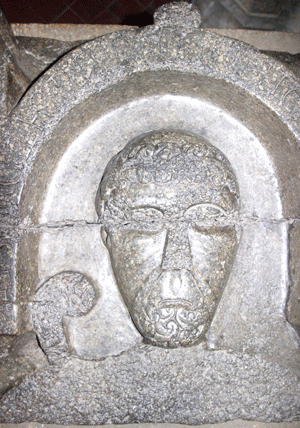 |
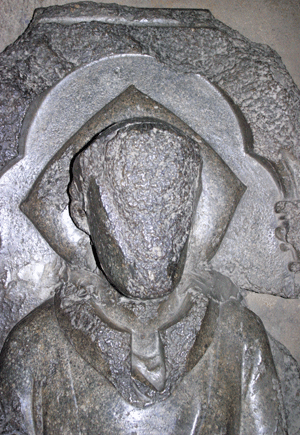 |
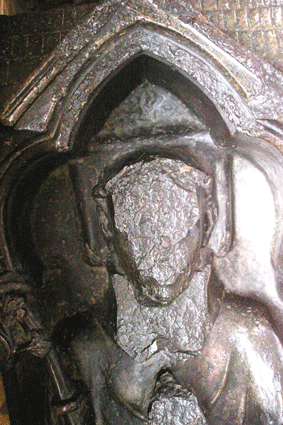 |
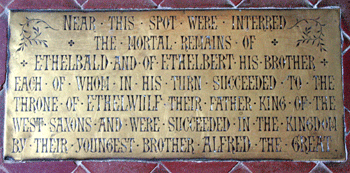 |
| Above top from
left to right:
Abbot
Clement ( 1150) Purbeck marble; top part of
slab only remains. Latin inscriptions identifies him. Priest (13th century) Purbeck
marble. An
Abbot (13th century)
Purbeck marble. The priest and the unknown abbot are also shown
below. Above bottom: The Anglo-Saon Chronicle states that King Ethelbald and King Etherlbert were elder bothers of King Ethelred (buried at Wimborne, q.v.) and of the more famous youngest King Alfred (buried at Hyde Abbey, Winchester, q.v.) . Excavations have revealed no remains and their only monument is this modern brass set into the floor. |
 |
 |
 |
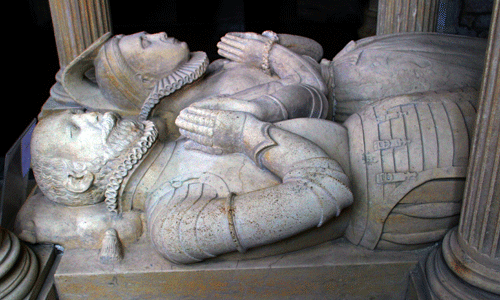 |
 |
| Left:
John
Digby, 1st Earl of Bristol (1698) & his two
wives, Alice (1658)
and
Rachel
(1708/9) Very
large marble standing monument.
Corinthian columns, urns, arms, putti. Effigies of John
Digby and his two wives; he holds his coronet; his wives
hold burning hearts. signed by Nost Above and right: John Leweston (1584) & Joan (1579) By Allen Maynard Below left top: John Lewesten (1584) The last of his line of Leweston Manor. 'There is no trace of the tablet originally in this frame, or the wording thereon. The plate was placed here in 1921 by George Hamilton Fletcher of Leweston Manor.' Below left bottom: George Hamilton Fletcher as above. No date Below centre left: Gareth Hamilton Fletcher (1915) Kia 'in the front trenches at Cuinchy, La Bassée, France' Below centre right: Laurence Rowe Fisher-Rowe (1915) 'The Old Friend' Lt Col the Grenadier Guards. Dow Battle of Neve, France. Below right: Robert (1726) & Mary (1729), 2nd son and eldest daughter of John Digby above. Marble tablet with epitaph by Pope |
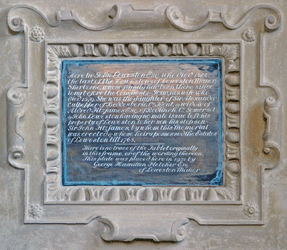 |
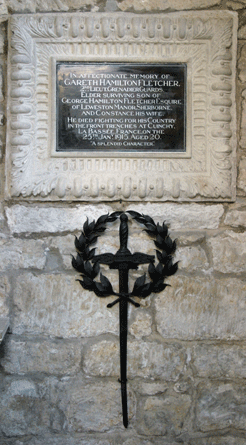 |
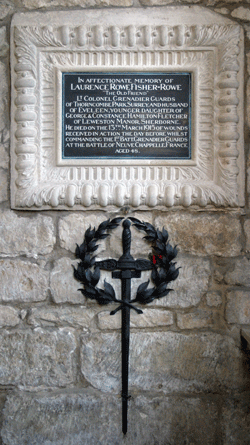 |
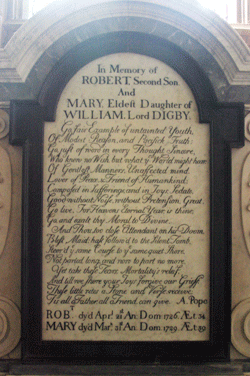 |
 |
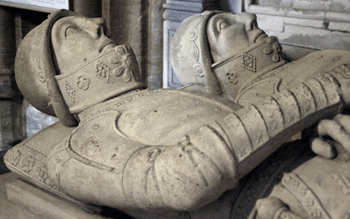 |
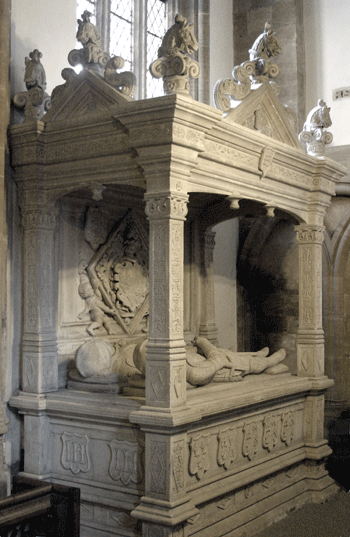 |
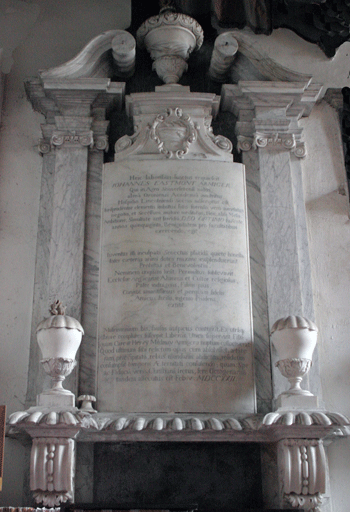 |
 Johan Walcot (1630) English inscription |
|
Above and near right:Sir John Horsley (1546) & son (1564).
Sir John bought the Abbey at the Dissolution. White
stone, two recumbent effigies on tomb chest with
shields; canopy. Coat of arms in lozenge against
back wall The rather exotic armour is based on that worn
in about 1470. The monuments was originally in the north
transept. Next Right: John Eatmont (1722/3) Latin inscription |
| Other Monuments |
|
Sarah, daughter
of Charles King (1710) Floor slab,
ambulatory Emorbus Johnson (1614/15) Floor slab, St Sepulchre chapel George Brown (1709) & wife Izor (1711); Dorcas (1679), wife of James Brown & their daughters, Dorcas (1689/90) & Unity (1701); George Brown (1692) Floor slab, ambulatory Eliza, wife of James Pidle (1710); Simon Aish & others Floor slab, ambulatory |
| If you visit Sherborne Abbey after, say, Wimborne Minster you may wonder why there are so few wall monuments: the answer is that most of them have been resited - and tucked away - in Bishop Roger's chapel at some time in the past. The room may be locked but a member of staff will be happy to show it to you. I photographed most of them but many are set very high and difficult to read especially as I did not have a good enough lens to render reading possible. |
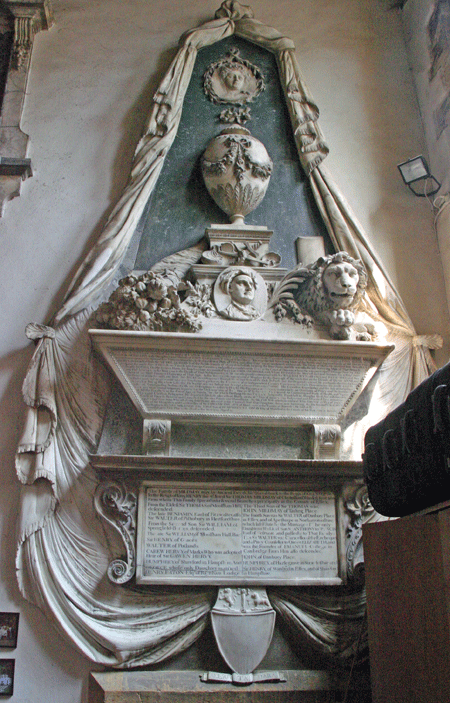 |
 |
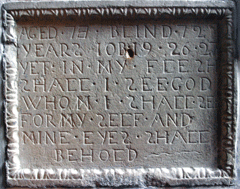 |
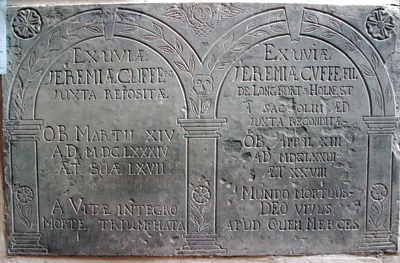 |
||
| Carew Hervy Mildmay (1784) & first wife Dorothy (1743). A very large wall monument with draperies, lion, obelisk and urn. Portrait medallions of commemorated and his wife. By Thomas Carter of Picadilly |
John Cooke (1766) & Penelope
(1767) Marble 'Near this place he interred the
remains of...' The upper tablet to the right of the above is to James Fellowes (1799) & Jane (1828) surgeon. '...whose remains are deposited in the vault of St Mary's Church, Lambeth' Below this: John Beale (1831) & Sarah (1820) '...in a vault near this tablet' |
Top:'AGED 78 BLIND 72 YEARS' No name or dates; all the S are reversed Bottom:Jeremiah Cuffe (1673) & Jerimiah, his father (1684/5) Slate tablet |
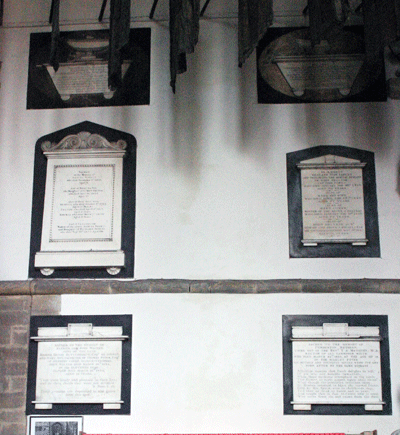 |
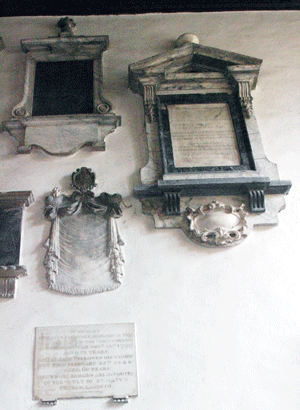 |
 |
| Above are a number of high set wall tablets which are set high and which I could not clearly photographs; below is a list of wall momuments in the chuch some of which may well correspond with those above |
|
Walter Cowth (1675)
Stone
tablet with two panels Dr John Bartlett (1703) Slate wall tablet, incised with cartouche John Derbie (1713) & Mary (1717) Alabaster wall monument with tassels, lamps and cartouche. Mary (1741) , wife of Rev John King. Marble & stone wall monument with Doric columns & urn. Jeph. John of Lincoln's Inn (1742) Marble wall monument with scrolls and urn. James Blackmore (1746) & Anne (1745) Marble wall monument with broken pediment and urn. John Wickham (1751) & Esther (1745/6), his first wife & Gertrude 1789), His second. Marble wall monument with urns and black cartouche in rococo frame. George Buchanan (1826) Wall monument with shield with arms. Samuel Whitty (1833) & others. Wall tablet by T Tyler of Bristol Pemberton Methuen (1835) Tablet by G Crawford Alfred & John Walter Butterworth (1835) As above |
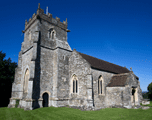 |
Silton - St Nicholas |
| O/S Ref: ST 783 293 |
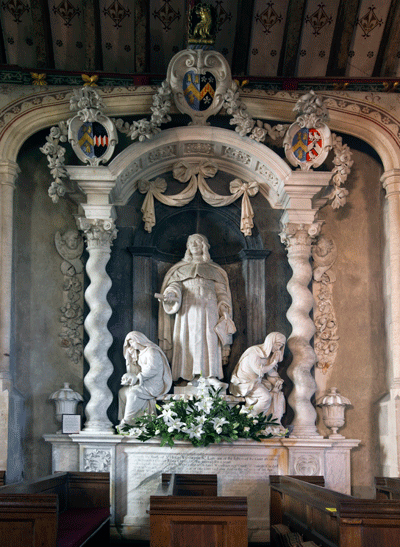 |
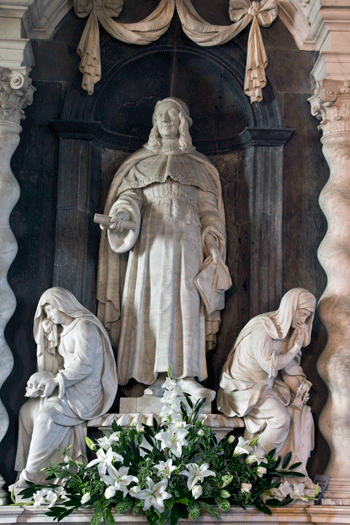 |
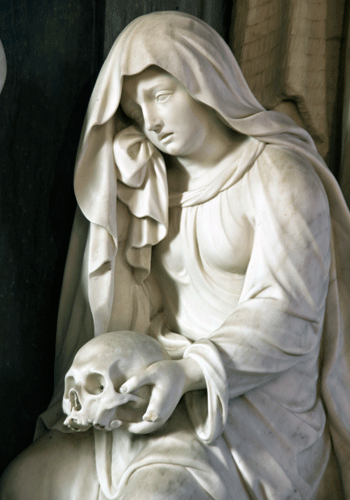 |
 |
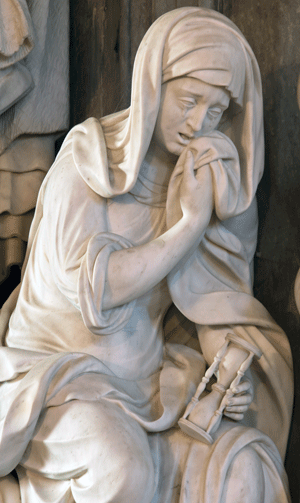 |
| Sir Hugh Wyndham (1684) wearing judges' robes. By John Nost (1692) The figures at his feet represent his first two wives. Originally in the chancel. | ||
 |
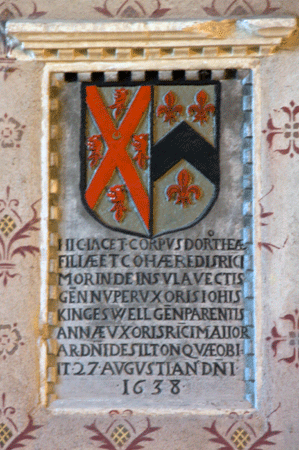 |
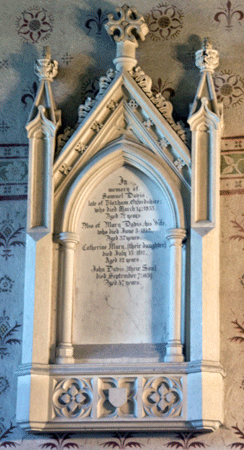 |
| Albinus Martin (1790); his wife Mary (1824) & sons Albinus (1788), and Harry Martin (Clerk) (1832); his 1st wife Elizabeth (1806), and 2nd wife also Elizabeth (1823). Selina (1837) wife of Rev. Harry, son of Harry (Clerk) & his 2nd wife Elizabeth | Dorothy (Morin) Kingeswell (1638) | Samuel Davies (1833) Marble tablet in stone surround by Chapman of From |
 |
Stalbridge - St Mary |
 |
| Church open. Park in road outside
O/S Ref: ST 733 182 |
 |
 |
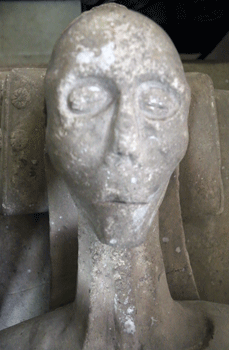 |
| Above and below:
Two table tombs of the late 15th or early 16th centuries;
one has a cadaver effigy Below far right: Head of medieval lady, now loose and on window sill. Was it from a lost tomb? |
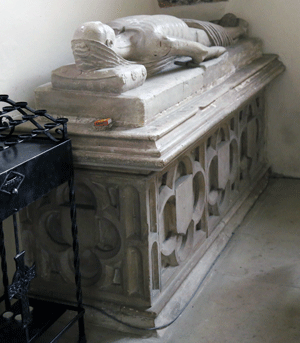 |
 |
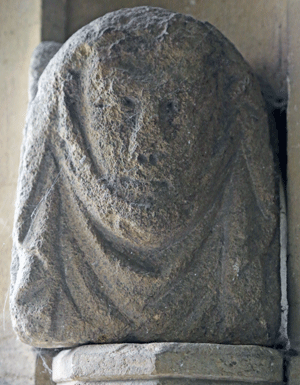 |
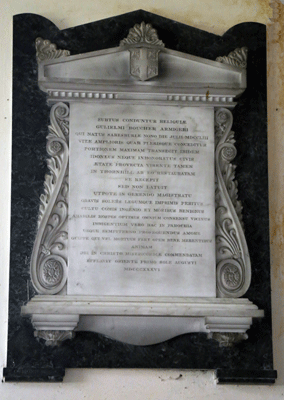 |
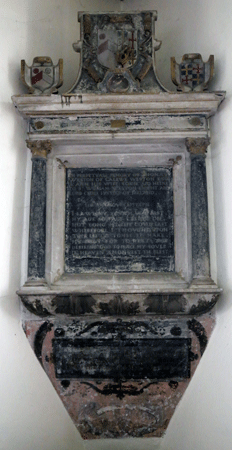 |
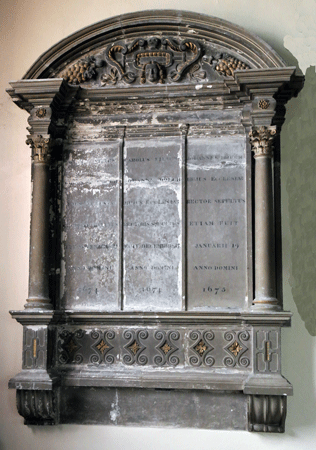 |
 |
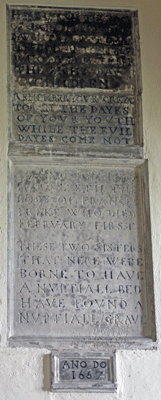 |
| William Boucher (1836) Latin inscription. Osmund of Old Sarum | Thomas Weston & Anne ND painted stone 17th century. Weston impaling Willoughby | John Douche (1675) rector and sons James & Charles (1674) Clunch with painted inscription. | Sarah Bradford (1810), Rev Edward Bradford (1837), rector; son Edward Pager Bradford (1822) H. Hopper of London | Ciscily Freke (1667); Francis Freke (1665) |
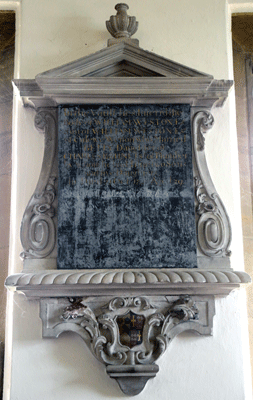 |
 |
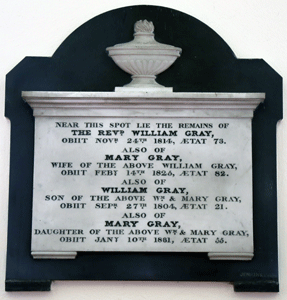 |
 |
|
| William Weston (1727) Slate with painted lettering. Weston impaling Brune |
Above:
Rev William Douche (1648) &
Joanna (1667) Below: Sgt Howard J Brown Dorset Q O Yeomanry. Kia Battle of Acacia, Egypt 1916 |
Rev William Gray (1814), wife Mary (1825), son William (1804), daughter Mary (1831) Jenkins of Poole | Mary Clarke (1840) |
 |
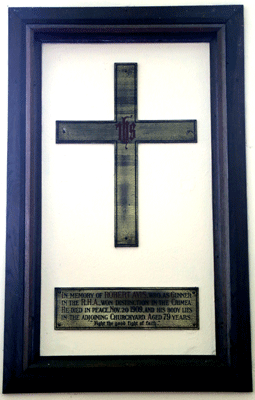 |
| L-Corp William Bradford 2/VIII King's Liverpool Regt. 1918 Burmese & Afghan Ward. 2 medals | Robert Avis Gunner in RHA Won distinction in Crimea |
 |
Stourton Caundle - St John |
 |
| Church will probable
be open but you may need to check. Park in lane outside
There are no toilet facilities or water. O/S Ref: ST 715 152 |
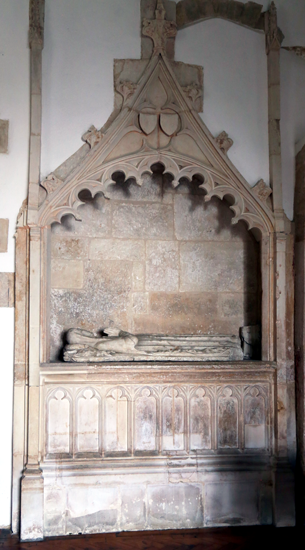 |
 |
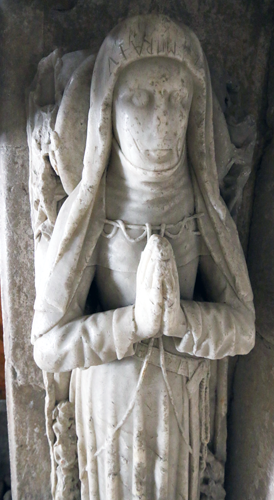 |
Left, above and right:
[RCHM
1 & 2) 15th altar tomb with canopy; no indication to whom it
belonged. Reset into this is a 15th century alabaster effigy of
an unknown lady.
|
  Left:
Aylen de Tavora Luis Ferbandes (1921) Left:
Aylen de Tavora Luis Ferbandes (1921)Right: The Serrell family 'buried in this church near this spot, according to the dates prefixed to their name' I have omitted the surname in every case, except the last for obvious reasons. 1770 March, Samuel; 1770 May, John, his twin brother; 1776, Elizabeth, widow of Samuel Snr and mother of the above twins; 1795 Elizabeth, daughter of the above John; 1805 Mary, widow of the above John; 1813 Elizabeth, daughter of the above Samuel & Elizabeth; 1813 Anne, sister of the last named Elizabeth; Post-captain John Haskolls RN, son of the above John & Mary; 1862 Eliza, widow of the above John Haskolls; 'lies buried beside her husband in the centre aisle...'. Also: 1901 Dalton Haskolls JP , 3rd son of John Haskolls & Eliza. 'buried in the cemetery'; 1923 Geraldine Agnes 1941 Alice Florence The last were the daughters of Rev Henry Digby Serrell Note: Post-captain is an obsolete Royal Navy rank to distinguish an officer with the rank of captain with the officer in charge of a ship who was, and still is, addressed as caption even if he is of a lower rank, such as commander. |
 |
Tolpuddle - St John |
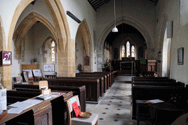 |
| Church open. Park in
road nearby. Village of the Tolpuddle Martyrs.
Only one returned to his native village and died in the
workhouse there; his grave in the church yard is shown
below O/S Ref: SY 791 945 |
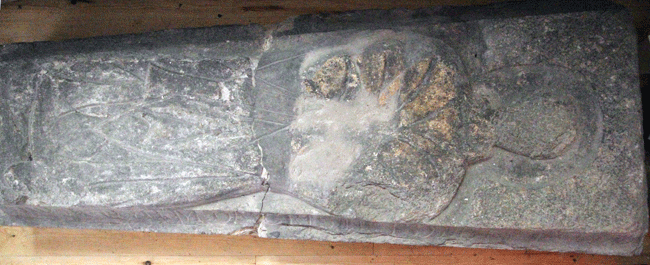 |
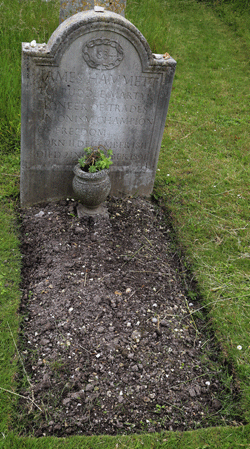 |
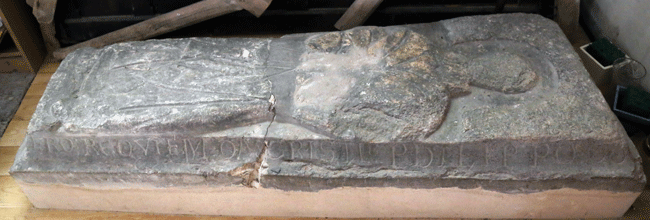 |
|
| Philip, a priest, 12th century stone of Purbeck Marble. Reset in north transept. The inscription reads: SIQIS AMAT XPM QI SARCO[P]HAGVM [VIDET] IST[V]M DICAT PRESBITERO REQVIEM DA CRISTE PHILIPPO |
James Hammett (1891) One of the Tolpuddle Martyrs, the only one who returned to the village |
 |
Trent - St Andrew |
 |
| Park in village
outside the church. The church is normally unlocked but the
chapel where there are several monuments, has a locked barrier
and is alarmed; some but not all of the monuments can be
photographed over the barrier. O/S Ref: ST 590 185 |
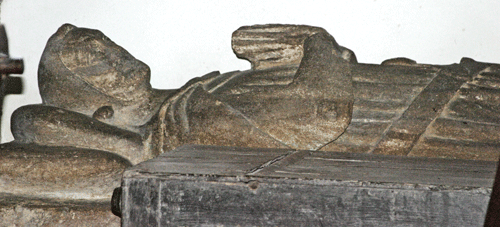 |
 |
|
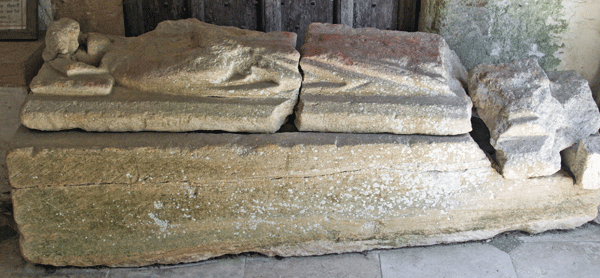 |
||
| Above
top: Civilian (14th century)
stone, wears hooded gown and carries sword;
feet on dog. In this chapel there is also Knight (c. 1380) Stone, head on helm with crest of bird; feet also on dog; I was unable to gain access to photograph this effigy. Above Bottom & right: Priest (14th century) very damaged; in porch |
||
 |
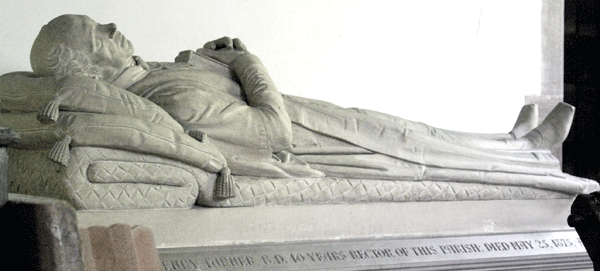 |
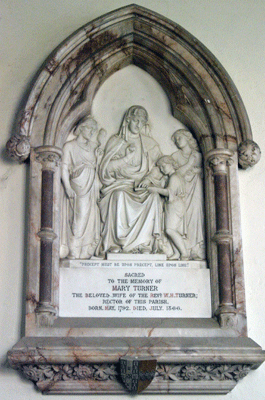 |
 |
| Sir Francis Wyndham (1715/6) White marble tablet | Revd William Henry Turner
(1874) Recumbent effigy with hand crossed over a Bible. By W Theed (1853) |
Mary Turner (1866) | George Beaver (1801) |
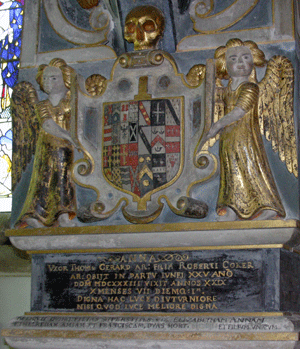 |
 |
 |
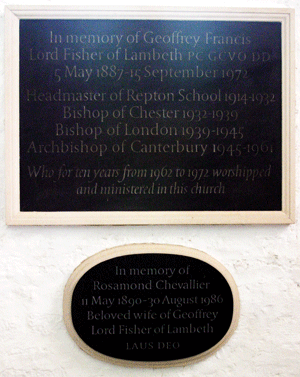 |
| Ann Gerard ( née Coker) (1633) Two side columns supporting an entablature with arms, supported by angels. Soffit of arch above painted with genealogical tree with shields of arms (forty of these) of Gerard and Coker and alliances. | Tristrum Storke (1530) & Alies. Painted stone panel with arms. | Thomas Hussey (1630/31) Stone wall monument | Lord Geoffrey Fisher of Lambert, Archbishop of Canterbury (1972) & his wife Rosamund (1986) . Simple wall tablets. Lord Fisher retired to Trent and he and his wife are buried in the church yard. |
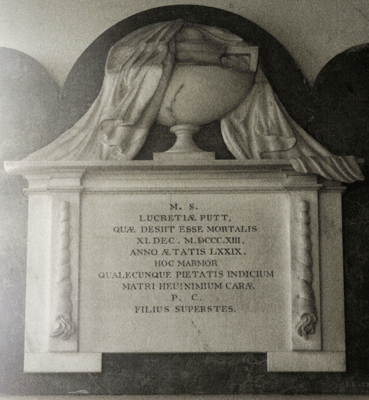 |
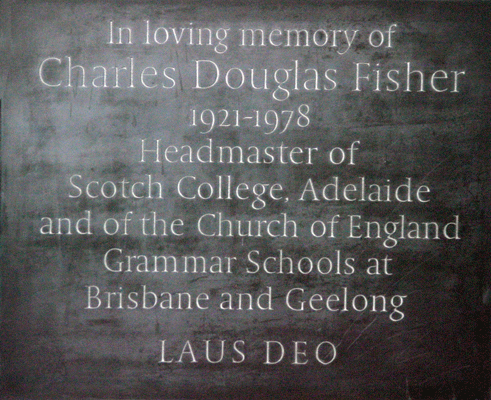 |
 |
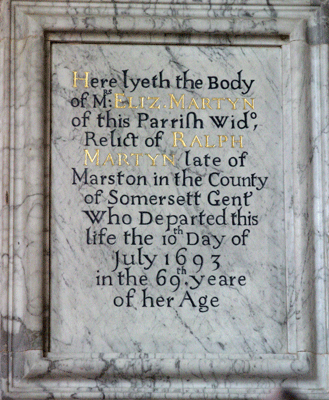 |
| Lucretia Putt (1813) | Charles Douglas Fisher (1978) Headmaster in Australia Tablet | Rev Thomas Back--m (18__) wall brass | Elizabeth Martyn (1693) Marble panel |
 |
|
| WAREHAM |
| There are two churches of interest, from
our point of view, in Wareham at either end of the
B3075,
which is North Street at the top end and
becomes South Street where it is crossed by East Street/West
Street about half way down; effectively the High Street. There's
a conveniently placed and inexpensive car park signposted about
half way. There are a number of eateries along the street but
avoid the one that serves only granary bread,
unless you want to risk an expensive dental bill, of course. St
Martin's-on-the-Wall is at the top end (and actually in North
Street) and the Priory Church of Lady St Mary at the bottom -
but a little off South Street in Church Lane. All are well
signposted. Churches aside, Wareham is a delightful town and well worth visiting. |
 |
Saint Martin's-on-the-Walls |
 |
| On the old town wall at the top of North
Street. There is some limited street parking nearby but there's a car park
fairly near as mentioned above. There's a notice on the door stating that the church may be open but, if not, the key may be obtained from a shop a short walk away on the opposite side of the road. The shops close Wednesday afternoon so that is a time to avoid. O/S Ref: SY 925 877 |
 Col. Thomas Edward Lawrence (1935) 'Lawrence of Arabia' By Eric Kennington. The effigy is of Portland Stone and the base of Purbeck Marble. |
 |
 |
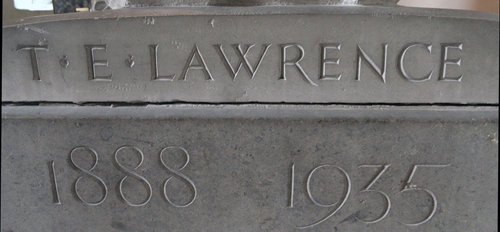 |
| Some Notes on the Col T E Lawrence Monument |
| Eric
Kennington, a friend of Col. Lawrence, began work on the effigy
after the latter's friends were unable to decide what form his
memorial should take. T E Lawrence's brother - A W Lawrence - came
to see it in Kennington's studio and paid £2,000 for it. Col.
Lawrence had been killed in a motor cycle accident in 1935 and
was buried in the church yard of St Nicholas, Moreton but the
then rector - Rev Mr Kinloch - did not want the effigy in his
church as he felt 'it would detract from the beauty of his
church'. The group, it seems, approached Salisbury Cathedral
but it seems that the Dean wanted an upright effigy of Col.
Lawrence in RAF uniform; this is rather curious as Col Lawrence,
although he did become an airmen after discharge from the army,
is more associated with the latter.
It seems Col Lawrence had an interest in the Crusades and had
intended to write a book on effigies with Eric Kennington. Col
Lawrence had been a frequent visitor to the town and St
Martin's. The group visited the Rector of St Martin's, the Rev
Mr Howe, who accepted the effigy being placed in the church. It
was installed in September 1939. The effigy based on the style of a military effigy of around 1300, complete with crossed legs, and is of Portland stone on a base of Purbeck marble. He wears Arab robes and head-dress; his right left hand holds the hilt of a curved dagger while his left rest by his side. His head rests on a camel saddle at the side of which are three unlabeled books, said to represent those he carried on his Arab Campaign: Mallory's Morte d'Arthur, The Oxford Book of English Verse and The Greek Anthology. His feet rest on a Hittite piece of sculpture, reminding us of his days as an archaeologist. There is a bronze portrait bust of Col T E Lawrence, also by Eric Kennington, in St Paul's Cathedral London. |
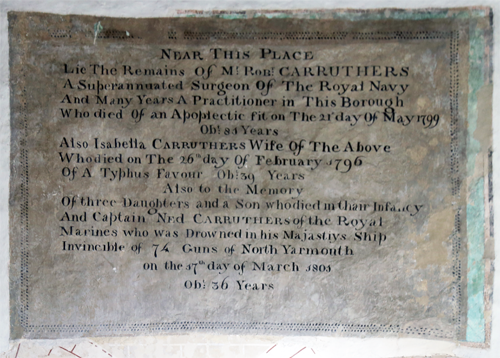 |
| Monument to Mr Robert Carruthers and family. This is high yo on the wall, but can be read directly from the above photograph |
 |
Priory Church of Lady St Mary |
 |
| In Church Lane. You may park nearby but it
is probably better to use the car park referred to above. The church is normally open but only when there is a guide in attendance, although there is no information on the internet about this that I could find. I did contact the central Wareham church office for information but they did not reply. However the church was open and the guide, a lovely lady in her 90's, was very helpful and welcoming. O/S Ref: SY 925 872 |
 |
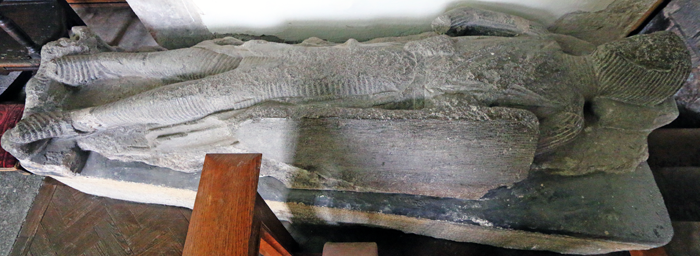 |
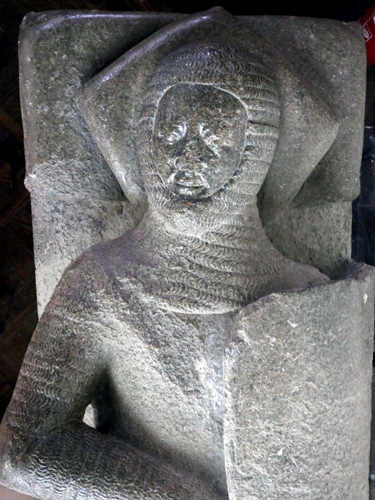 |
|
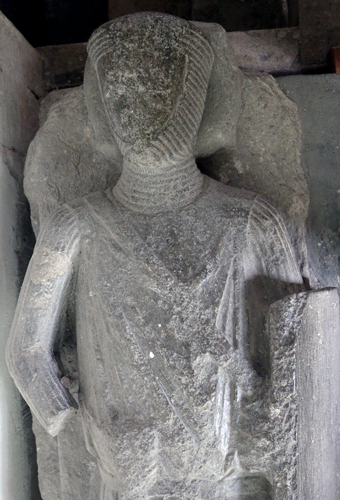 |
 |
 |
 |
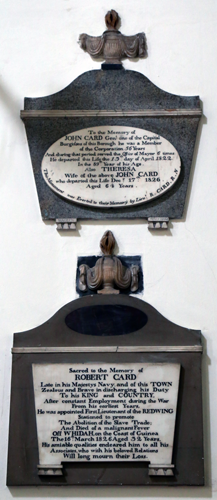 |
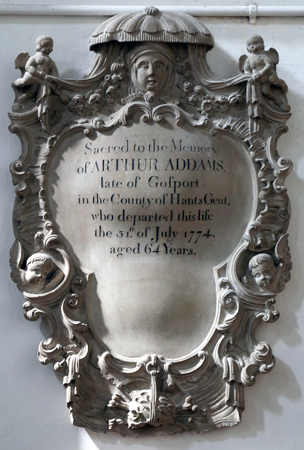 |
| Above from left to right: 1) [RCHM 1771] Andrew Trew (1771). 2) [RCHM 36] Robert Dugdale (1766), his nephew, also Robert Dugdale (1788), and his nephew, also Robert Dugdale (1851) And the latter's two wives: Elizabeth (1817) & Susannah (1848) 3) [RCHM 21] Humphrey Giles (1789) and his wife, Sarah (1805) 4)Top [RCHM 9] : John Card (1822) and wife Theresa (1826) Signed: WARREN WAREHAM.; Bottom: [RCHM 10] Robert Card RN (1826) 5) [RCHM 32] Arthur Adams (1774) | ||||
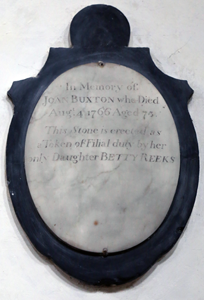 |
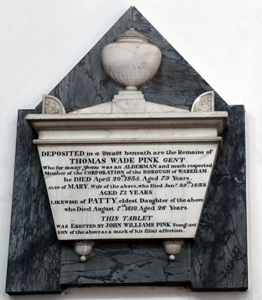 |
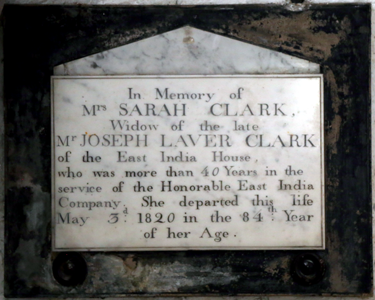 |
 |
 |
| [RCHM 30] Joan Buxton (1766) | [RCHM 35] Thomas Wade Pink (1855), his wife Mary (1852) and their daughter Patty (1810) Signed: G & W Slade, Dorchester | [RCHM 23] Sarah Clark (1820) | [RCHM 22] Rev John Hutchins AM (1773) Rector of Wareham and Swyre, and author of The History and Antiquities of Dorset. | [RCHM 18] George Ryves Hawker MA (1789) 'Rector of the united Parishes of this Borough' And his infant daughter, Caroline |
 |
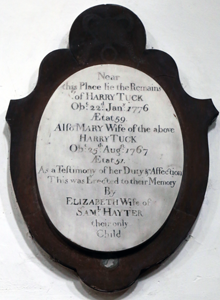 |
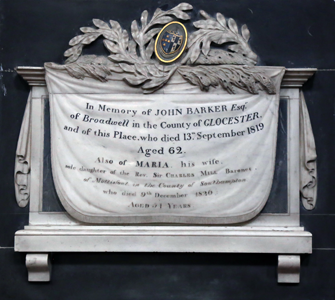 |
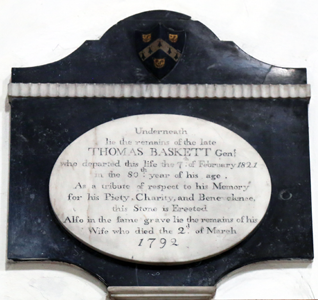 |
 |
| [RCHM 28] Mary Wright (1805) Signed: Hiscock, Poole |
[RCHM 27] Harry Tuck (1776) and his wife, Mary (1767) | [RCHM 29] John Barker (1819) and his
wife Maria (Mill) (1826) Signed: I Kendall, Exon |
[RCHM 31] Thomas Baskett (1821) 'Also in the same grave the remains of his Wife who died 2nd March 1792' Another 'Pevsner' here but at least his unnamed wife is given a capital letter! Signed Warren, Wareham | [RCHM 13] Geo Gigger (1894) and his sister , Eliz Chapman (1802) |
| Other
Monuments (The reference numbers below refer to the RCHM listing) |
|
| 1) Cpt George Lefebure
(1812) Royal Horse Artillery. 2) Mjr Gen Sir Granby Thomas Calcraft Kn (1820) 1st Reg of Light Dragoons & 32 Reg of Dragoon Guards (son of J) 3) Mjr Charles Lefebure (1810) Royal Engineers. KIA Fort Matagorda (Spain) 4) Richard Calcraft (1819) (son of J) 5) Mjr William Calcraft (1809) 7th Light Dragoons 6) Elizabeth Calcraft (1815) Wife of John Calcraft. Signed: Bacon 7) John Calcraft MP (1772) 8) Rt Hon John Calcraft PC MP (1831) 9) see above 10) see above 11) see above 12) see above 13) see above 14) Robert Carruthers RN (1799) surgeon, amd his wife, Isabella (1786). '...their remains are deposited in the church of St Martin with four infant children...'. Their sons: Capt Ned Carruthers RM (1801), drowned at sea in HMS Invincible aged 30; Lt Chas Lawrence Carruthers (1804) aged 28; and Cpt Walter Serling Carruthers RM (1810), drowned at sea in HMS Rodney, aged 29. 15) Henrietta Carruthers (1825) With draped urn 16) Thomas Garland (1828), his wife Betty (Watts) (1805), nine children and others 17) William Dugdale (1844), mayor, his wife Mary (1824) and five children. Signed Lester Dorcester 18) see above 19) Tomb recess, late 13th century. South wall 20) Tomb recess, late 13th century |
21) see above 22) see above 23) see above 24) Rev George Hooton Hyde MA (1828) and wife Diana (1825) and four children. Signed: T Tyler, Bristol 25) 'In the vault beneath are deposited the remains of...' Elizabeth Satines (1809); her son, Joseph Staines (1824); his widow, Fanny (1846). 'And also in memory of...' Rev Joseph Staines Cope (1902), buried at Chaldon Herring; his wife, Elizabeth Pyle (1838); and their son William Henry (1832), aged 6 months. Signed: Osmund, Sarum 26) Thomas Bartlett (1803), his wife, Alicia (Oldfield) (1779), two children and aslo son Thomas (1836) and his wife Anne (Vincent) (1799) and their son John (1770) 27) see above 28) see above 29) see above 30) see above 31) see above 32) see above 33) An arch from a 14th century tomb recess now set over entrance to Saint Edward's Chapel. 34) see above 35) see above 36) see above A) Commander John Hales Montagu Calcraft MP (1868) RN. B) William Montagu Calcraft (1901) (son of JH, MP). 4) C) John Hales Calcraft MP (1880) (son of Rt Hon J) |
| West Chelborough - St Andrew |
| O/S Ref: ST 442 055 |
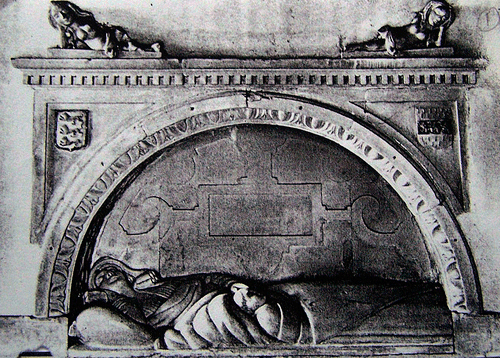 |
| A lady of the
Kymer
family, early
17th century; she
is presented lying in bed under a blanket with a
small child. With thanks to Jean McCreanor for sending me a print of this curiosity; I have not seen it |
| West Knighton - St Peter |
 |
| O/S Ref: SY 733 876 |
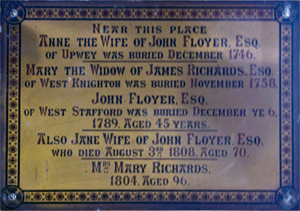 |
 |
 |
| Above:
Anne Floyer (1746), Mary
Richards (1758), John Floyer (1789), Jane Floyer
(1808), Mrs Mary Richards (1804) Right: Catherine Waddle (180_) Far Right: John Adair Hawkins (1842) & Jane (WIlliams) (1863) his wife. Marbles |
| West Stafford - St Andrew |
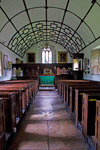 |
| O/S Ref: SY 726 896 |
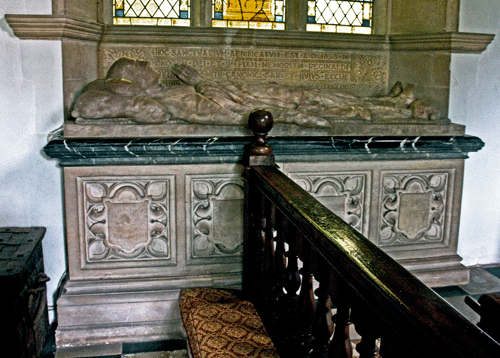 |
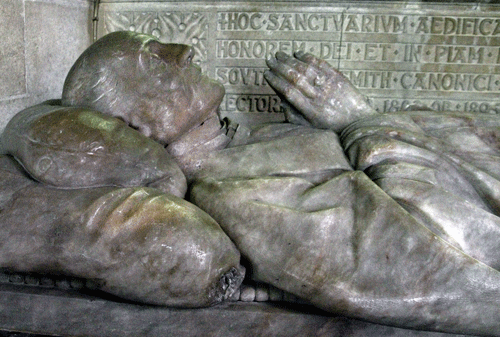 |
| Canon Reginald Southwell Smith (1895) | |
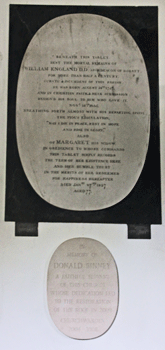 |
 Blanche Exerton (no dates) |
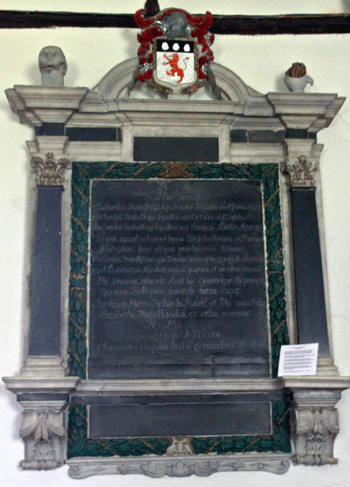 Richard Russell (1638) & Richard Russell (1660) & Richard Russell (1667) Rectors and Patrons. Marble and slate. Erected 1674 |

John Gould (177) Marble |
| Above:William England DD Archdeacon of Dorset (1835) & Margaret, his widow (1837) Signed Lester, Dorchester. |
|
Whitchurch Canonicorum |
Shrine of
St Wite A complete but plain stone shrine - very rare.
The three "portholes" in the front of medieval shrines are said
to have been based on the Holy Sepulchre in Jerusalem where the
actual rock slab on which Jesus's body lay was clad in marble to
either protect the rock or hide the damage that had been done to
it; the three holes allowed pilgrims to see and touch the rock.
shown (shown) Thomas de Lude (1300) part of brass of a foliated cross John Wadham (1584) Tablet of two panels, against the top of the left panel, a brass inscription Sir John Jeffrey (1611) Standing monument with recumbent effigy with much intricate strapwork on the chest and on the back wall Admiral Sir George Summer (1611) Brass of 1903 paid for by public subscription. He sailed with Raleigh |
| O/S Ref: SY 397
954 |
|
 |
 |
Wimborne Minster |
| Park in one of the town's pay car
parks. Open for visitors Monday - Friday 9.30am -
5.30pm; Sunday 2.30pm - 5.30pm.
Website My favourite church of all, which I first visited in 1966 and which celebrated its 1300 years in 2005. Not only does it have a fine collection of monuments with examples of many types but also much else of interest, including but also an astronomical clock and a chained library. It also has the only brass to an English King (actually King of Wessex). The church and the town itself are well worth a long detour. O/S Ref: SZ 009 999 |
| Wimborne Minster, Unusual if not now actually Peculiar |
Wimborne Minster has an unusual dedication: St Cuthburga who was the sister of King Ine of Wessex and wife of King Alfrith of Northumbria as well as the founder of the church at Wimbourne as a Benedictine abbey of nuns in 705. This abbey was destroyed by the Danes in 1013 although some of the buildings remained and it was refounded as a collegiate church - governed by a dean and twelve canons - by King Edward the Confessor in 1043. John of Berwich whose 19th century brass plate is shown below was the fifth dean. The form of organization is similar to a cathedral but a collegiate church is not the seat of a bishop. In 1318 King Edward II granted the church status as a Royal Peculiar, that is a church which is not subject to the jurisdiction of the bishop of the diocese in which it is situated. The collegiate church was dissolved by King Henry VIII who confiscated much of the wealth. Queen Elizabeth I in 1562 granted certain rights and prerogatives of the church affairs twelve governors; it remained a peculiar. This latter status was abolished in 1846 but the twelve governors still have control over some of the church's affairs. |
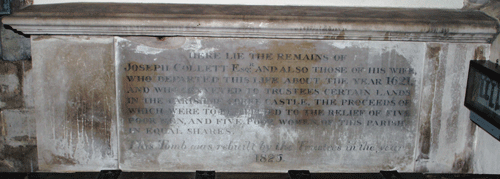 Joseph Collett (1621) & unamed Wife. 'who conveyed to trustees certain lands in the parish of Corfe Castle, the proceeds of which were to be applied to the relief of five poor men and five poor women of this parish in equal shares'. The tomb was rebuilt by the trustees in 1825 |
 |
'The Man in the Wall' | |
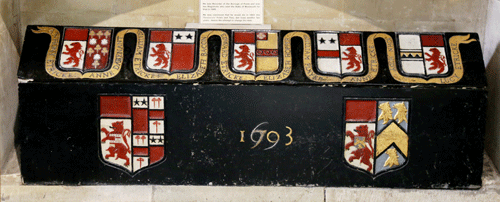 |
|||
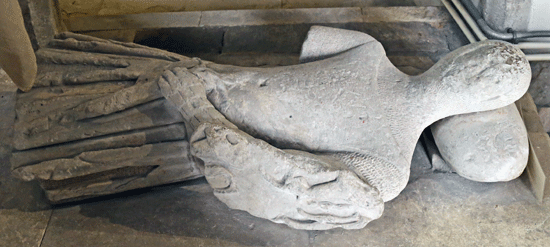 A Fitzpiers (late 13th century) knight Mutilated. Arms on damaged shield and nearby wall suggests attribution; the Fitzpiers were once lords of the manor of Hinton Martell. On 17th century table tomb. |
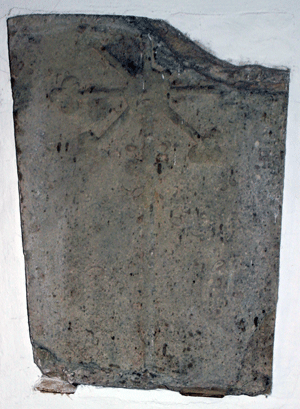 Broken slab with cross in relief: no details |
Above: Anthony Etricke (1703)
- "The Man in the Wall".Black slate coped
sarcophagus with painted shields; on it the date 1703,
which has been clearly altered from 1693, the date he
(incorrectly) foretold his death. He was recorder of
Poole and the Duke of Monmouth was brought before him
after the Battle of Sedgemoor. An eccentric man, he was
offended by the people of Wimborne so declared he would
be buried neither in their church, nor without it,
neither in their ground, nor above it. Afterwards,
desiring to be buried with his ancestors but not willing
to break his vow, he obtained permission to be buried in
the wall where his coffin was placed in his lifetime.
Left top: 'Underneath lie the remains of John de Berwick Dean of this church 1312' Dean John de Berwick (1312) Slab with 19th century brass plate, once part of table tomb around which parishioners used to meet annually to enquire into the affairs of the parish. The title dean here indicates that Wimborne Minster was collegiate church. |
|
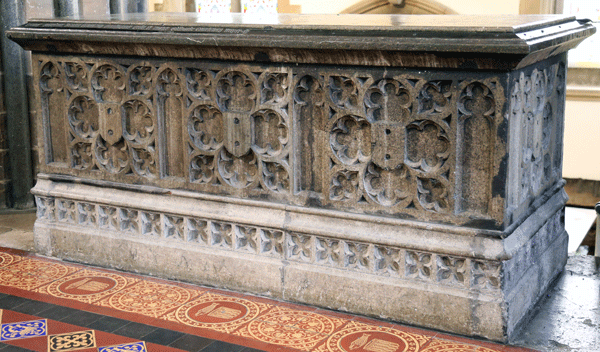 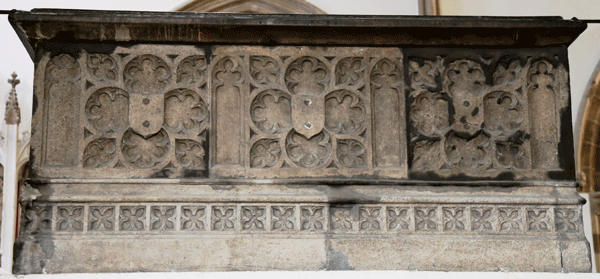 |
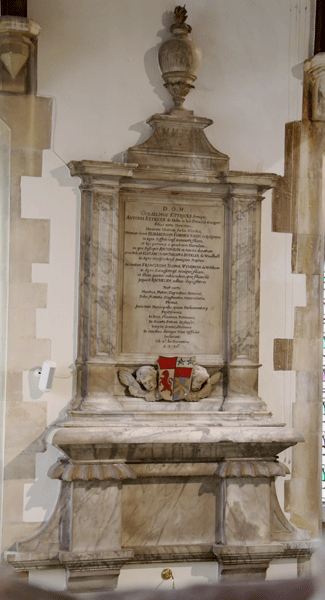 |
|
|
|||||
| Gertrude Courtenay, Marchioness of Exeter (1558) Purbeck marble tomb chest; edge retains part of black letter brass inscription. Brass shields lost from sides of the tomb chest. She and her husband were found guilty of treason under Henry VIII, her husband being executed. She was imprisoned in the Tower but later pardoned. | William Ettricke (1716) large white marble tablet with arms |
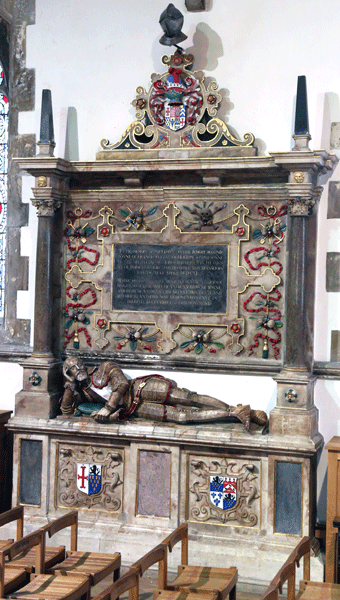 |
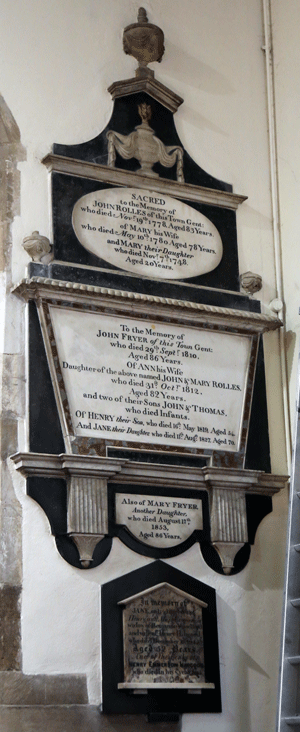 |
  |
|
||
|
Sir Edmund Uverdale (1606)
Alabaster
painted |
John Rolles (1779) & Mary (1780) Their daughter Mary (1748 age 20). John Fryer (1810) & Ann (1812), daughter of the above. Their children: John & Thomas (died in infancy), Henry (1819) & Jane (1827) | Top: Thomas Hanham (1650) of Middle Temple. Painted alabaster; two kneeling figures facing each other across a prayer desk. Arms and inscription. is a tablet with the name "Snodgrass" and together with the name "Wardell" in the baptistry is said to have been seen by Charles Dickens and used by him in Pickwick Papers |
Top:
Mrs
Elizabeth Reek (1802) Bottom: Margaret Ford (1819) wife of John MD FLS Left bottom: John Ray Les Wardell (1810 aged 8) |
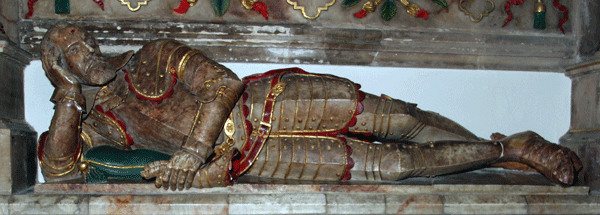 |
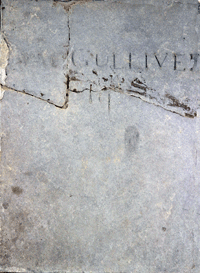 |
| Above:
Sir
Edmund Uverdale. Effigy (see above left for complete tomb) Right: Possibly the slab, now fractured and wall mounted, covering a vault. The name reads __GULLIVE_ |
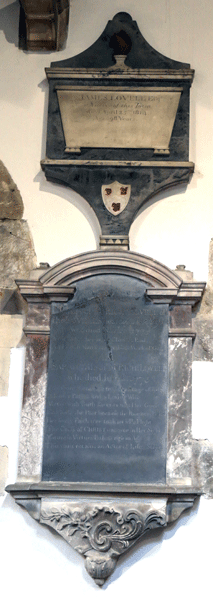 |
 |
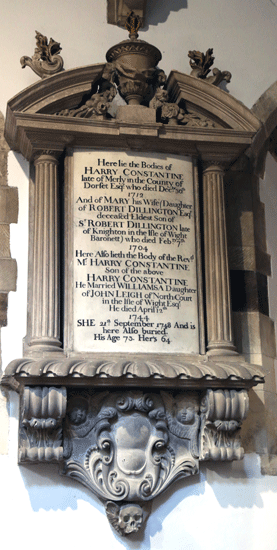 |
 |
 |
|
Above: Elizabeth
Loader (1777) her husband
John (1802)
Their daughter Elizabeth White (1825)
Left: James Lovell (1814) and below: Richard Lovell (1778) & Sarah (1773) |
Harry Constantine (1712), Mary (1704); their son Rev Harry (1748), his wife Wiliams. Marble. | Erected by William Fitch in 1705 during his lifetime for his parents, buried in the vault below. His wife Ann, himself and immediate offspring. No other names or dates given | George Beethell (1742) |
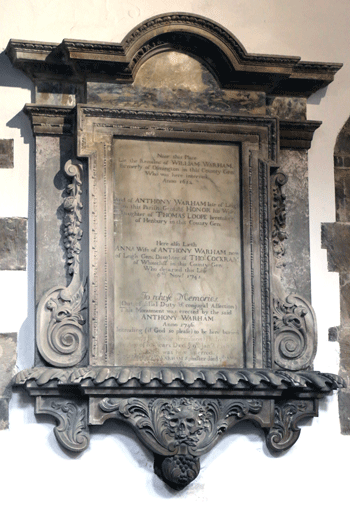 |
 |
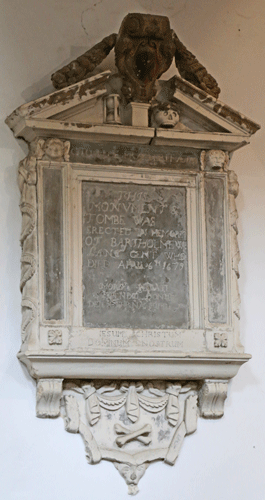 |
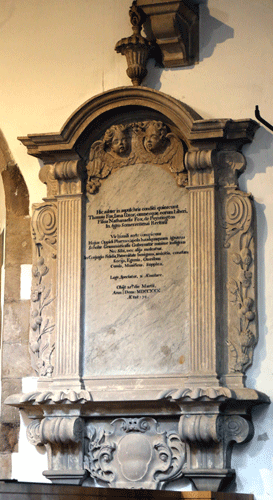 |
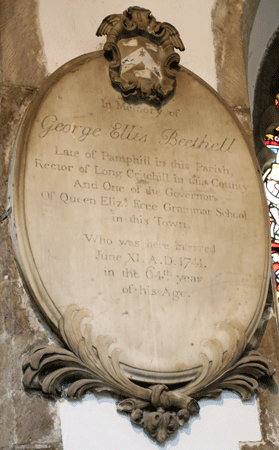 |
| William Warham (1612) and family: Anthony & Honor. Anna (1741), wife of Anthony (erected by Anthony 1746) stone and marble. | Mary Russell (1773) widow of William, one of the ministers of this church | Bartholemew Lane (1679) Slate with stone surround. | Thomas Fox (1730) tablet with Latin inscription | George Ellis Beethall (1741) |
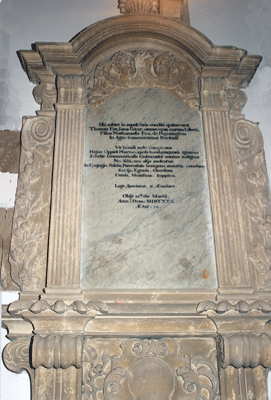 |
 |
 |
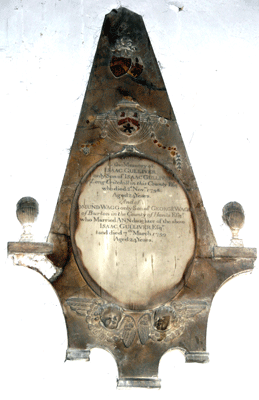 |
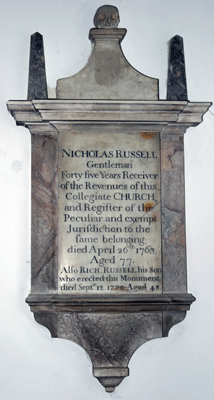 |
| Thomas Fox (1830), Iana (= Jane?) Son Nathaniel Rector of Poyntington | Anne Mary Caroline Linthorpe (1885) & her sister Caroline (1888) | Top:
Edward Butt
(1781) & 3 sisters: Abigail, Elizabeth & Mary Lower: Margaret (1803)- his widow - and their son Rev Edward Butt (1842), Vicar of Tollertratham |
Issac Gulliver (1798) & Edward Wagg (1799), his son-in-law | Nicholas Russel (1763). 'Forty five Years Receiver of the Revenues of this Collegiate CHURCH...' Also his son Richard (1772) |
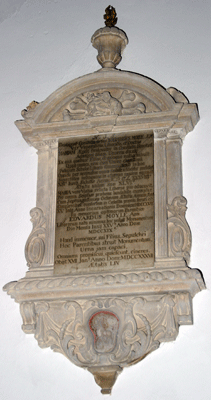 |
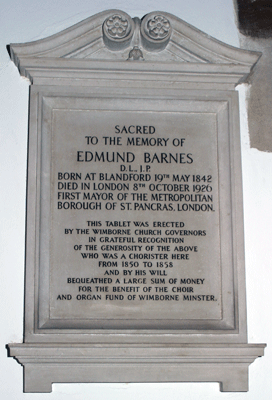 |
 |
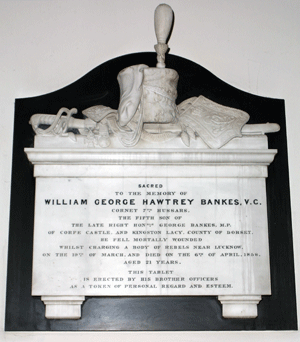 |
 |
| John Moore (17__) | Edmund Barnes (1926) was chorister from 1850-1858 and bequeathed a legacy in favour of the Wimborne Minster Choir and Organ Fund, which maintains the organ and provides for the choir school. He was first mayor of London Borough of St Pancras 1900-1902 | Charles Waldo Lionel Churchill (DOW 1902) 2nd Lt, died at Bushbult, South Africa. Only son. | '...mortally wounded charging a body of rebels mear Lucknow...1858...' William George Hawtrey Bankes VC (1858) Cornet, 7th Hussars, gained his VC in the Indian Mutiny. Aged 21 |
W. E(tricke) (1663) slate ledger stone |
| Monuments Not Illustrated |
|
Dean Thomas Brembre (1361) slab, not in situ |
| 'Willm Smith '(1587) 'Vicker of Sturminster'. Wall brass, text only. The wording suggests he was incumbent after his death! |
| Wife of Anthony Wayte (1619) floor slab, part inscription |
| Elizabeth Pope (1663) small stone panel |
| Robert Russel (1718) slate floor slab,arms |
| John Moyle (1719) tablet. This is the best of a series of late 17th and early 18th century tablets |
| George Bethel (1782) tablet |
| John Bayles Wardell (1810) age 8. Tab with simple sarchopagus |
| George Leckie (1812) B&W Tab |
| Percival Hart Dyke MA (1919) Canon of Salisbury; Rector of Compton Abbas. B&W Tablet similar to the above |
| Rev Charles Bowle (1841) 'for forty years one of the ministers of this parish'. Gothick tablat |
| Anthony Sarjeant (1829), Mary (1803), their children Jane (1811), Sophia (1822), James (1824), Mary Sutton (1840) Large B&W Tablet |
| Charles Onslow (1884) 'Presbyter of this Minster' Wall brass, text only. |
| Francis John Huyshe (1905) Vicar for 24 years. B&W Tablet |
| Wimborne St Giles - St Giles |
| O/S Ref: SU 033 120 |
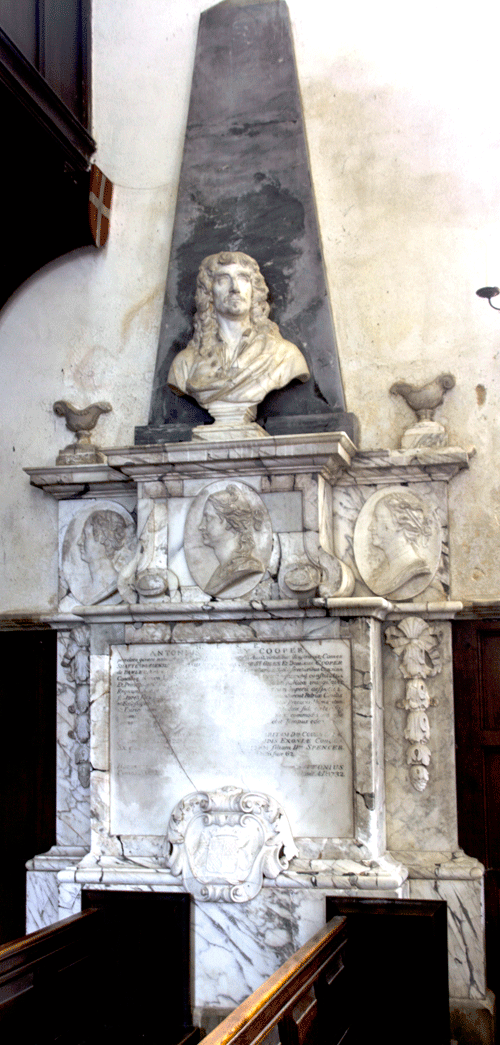 |
 |
 |
 |
| First Earl of Shafesbury (1683) Marble made later in 1732; bust by J. M. Rysbrack Marble |
Third Earl of Shafesbury (1712)
Granite |
Fourth Earl of Shafesbury (1771) Designed by James Stuart and made by Thomas Scheemakers Marble |
Fifth Earl of Shafesbury (1811) Marble by Rudolf Schadow 1819 |
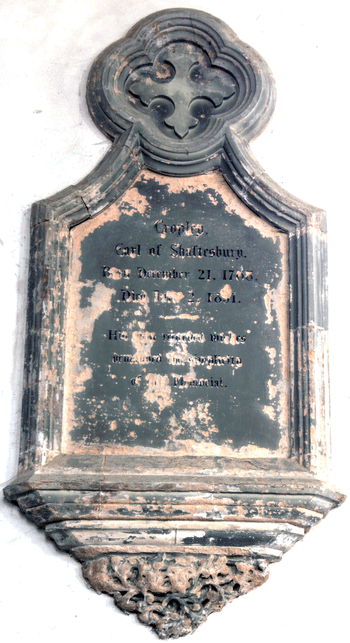 |
 |
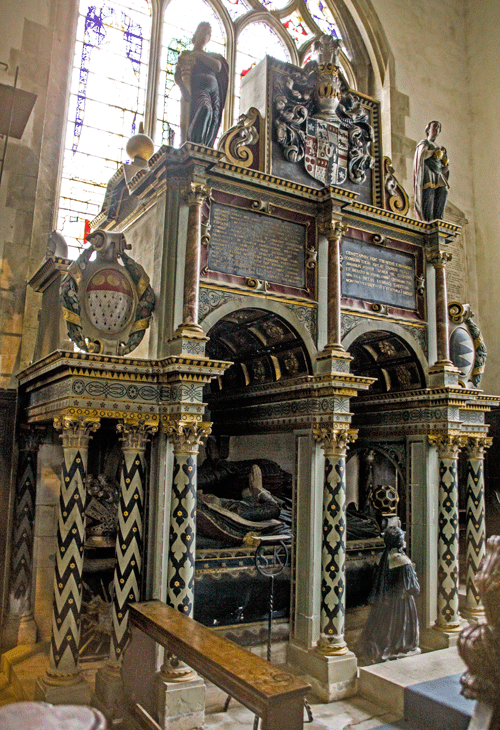 |
 |
|
Cropley Ashley-Cooper 6th Earl of shafesbury (1831) |
Anthony Victor George Allsopp, Midshipman RN (1914 aged 15) He served in HMS Hogue which with two other ships were torpedoed and sunk by a German submarine | Sir Anthony Ashley Bt (1628) & Jane (Okeover) A daughter (Anne) kneels on the floor in front of the monument. She was wife of Sir John Cooper and mother of the 1st Earl. Clunch and alabaster. | |
 |
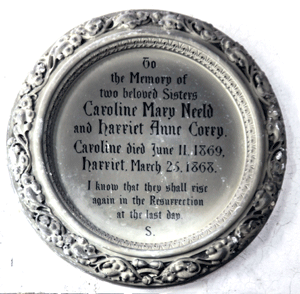 |
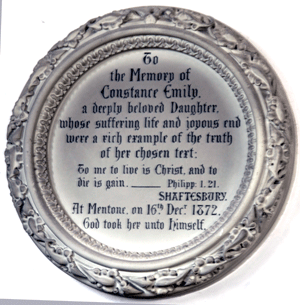 |
 |
| A series of 19th century wall monuments, all slightly different | |||
| Anthony Maurice William Ashley (1855), buried at Lausanne | Caroline Mary Neeld (1869) & Harriet Anne Corry (1868) sisters | Constance Emily ... (1872) | Mary Charlotte Ashley Cooper (1861) |
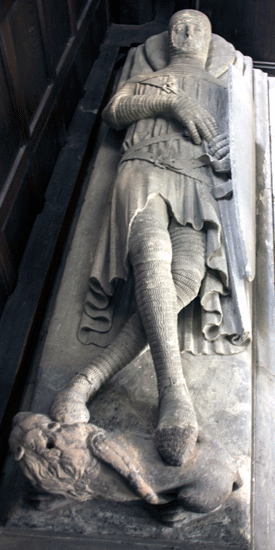 |
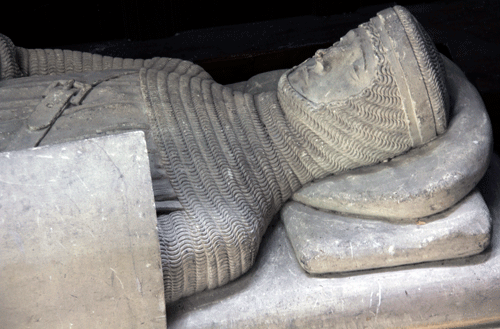 |
| Sir John de Plecy The church was damaged by a fire in 1908 and this effigy is mainly a copy of the early 14th century effigy which was here before the fire. |
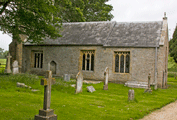 |
Winterborne Came - St Peter |
 |
| O/S Ref: SY 705 884 |
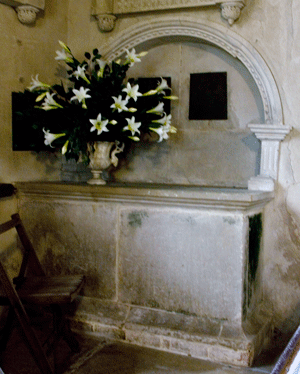 |
 |
 |
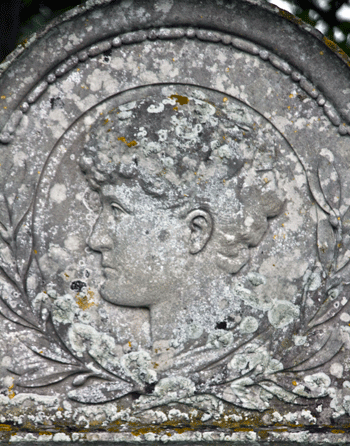 |
 |
|
Dorathy (Baylie) Meller (1591) Tomb and brass on back wall of tomb; a further brass with arms is obscured by the flowers |
Lady Mary Seymour (churchyard) |
Lionel Arthur Henry Seymour Dawson-Damer, 6th Earl of Portarlington (1959) & Air Comm. George Lionel Yuill Seymour Dawson-Damar, Vicount Carlow (kia 1914) son of the above. |
 |
 |
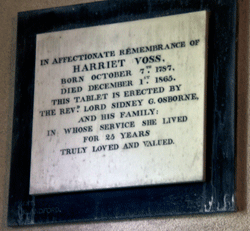 Harriet Voss (1865) 'This tablet is erected by the Revd Lord Sidney G Osborne and in family in whose service she lived for 25 years...' |
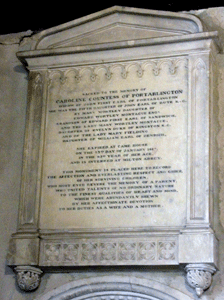 |
 |
| Rev William England (1846) and his wife Elizabeth (Dampier) (1874) By Osmond, Sarum | Hon Lionel Damer (1807) , son of the 1st Earl of Dorchester and Williamsea (Jannsen) (1825), his widow. Signed J Browne (London) 1839 | Caroline, Countess of
Portarlington (1813) Signed J Browne (London) Buried at Milton Abbey |
Louisa Frances Dawson Damer (1847) & others. By Lester, Dorcheste |
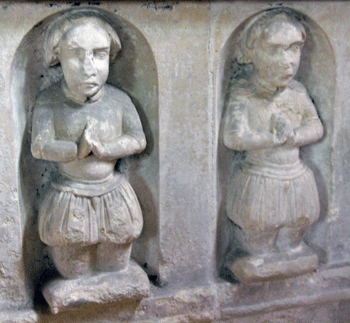 |
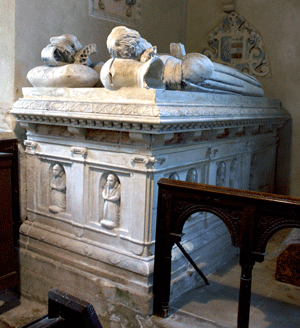 |
 |
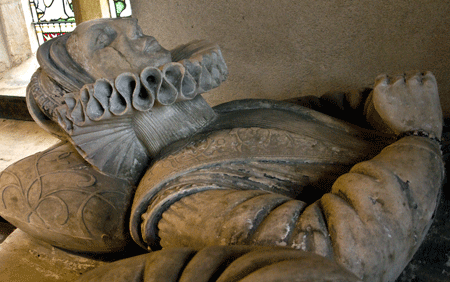 |
 |
 |
| John (no date) and Anne (1610/11) Meller. Arms on back wall can just be seen. | ||
